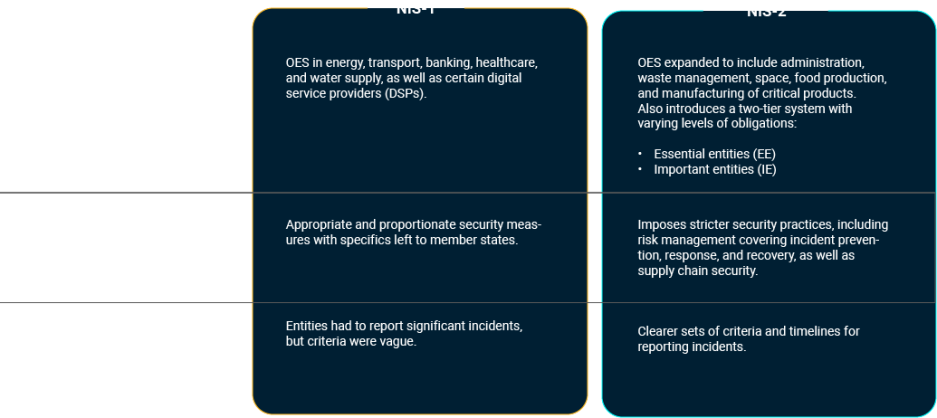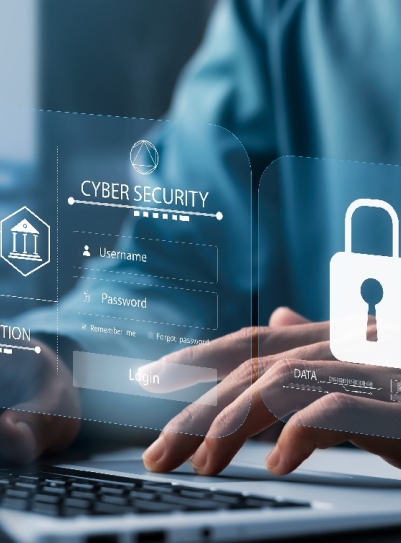
Protect your critical Systems& Devices from Cyberattacks

Systems and devices that no longer meet new industry standards poses a real cybersecurity risk. Proactively addressing cybersecurity risks can significantly reduce vulnerability to attacks.
Your roadmap to Cyber Security and Compliance
Achieving compliance with NIS2 and the Cyber Resilience Act (CRA) is a journey—but with the right partner, it becomes a clear path forward. Here's how leading businesses make the shift from risk to readiness:
• Assess Risks – Identify vulnerabilities across IT, OT, and supply chains.
• Monitor in Real Time – stop threats before they spread.
• Secure the Supply Chain – Ensure third-party vendors meet the same standards you do.
• Be Incident-Ready – Build response plans and report breaches.
• Train Your Employees – Increase cyber awareness and reduce human error.
Compliance is not an option — it’s essential for resilience
in a digital-first economy
Staying ahead of evolving regulations and threats, is essential when it comes to strengthening the security of your systems and devices.
The NIS-2 Directive represents the EU's most extensive cybersecurity framework to date. With stricter requirements for risk management and incident reporting, broader coverage spanning 18 critical sectors, and significant penalties for non-compliance, businesses are now compelled to reassess their cybersecurity strategy. In Germany alone, an estimated 29,000 companies must meet these new requirements by October 2024.
Comparison: NIS-1 vs. NIS-2

100,000+
€10M
18
Companies Affected
in Fines
Critical Sectors
Estimated number of organizations required to comply with NIS-2
Maximum penalty for non-compliance or 2% of global turnover, whichever is higher
NIS-2 now applies to 18 key sectors, including 11 classified as highly critical
The NIS-2 directive marks a significant expansion in scope and enforcement, impacting over 100,000 organizations across Europe. With fines reaching up to €10 million or 2% of global turnover, and 18 critical sectors are under regulation. Compliance is no longer optional —it’s essential for resilience in a digital-first economy.
Industry Sectors Affected By NIS2
Energy
Transport
Banking
NIS2 affects all entities that provide essential or important services to the European economy and society, including companies and supply chain.
Evaluate the category you are in to prioritize your cybersecurity efforts as critical sectors need the highest level
of protection.
Health
Water
Finance
IEC Standards Supporting
NIS2 Compliance
Digital infrastr.
Waste Mgmt
Postal Services
- ISO/IEC 27001
- IEC 62443
- ISO/IEC 27019
Chemical
Food
Space
While ISO certifications are not explicitly a prerequisite for compliance with the NIS2 Directive, it can be extremely beneficial in demonstrating compliance. While NIS2 does not mandate specific standards like ISO 27001, its requirements align closely with the principles of established cybersecurity and risk management frameworks.
Contact Us
Act, While Others React.
As your complete technology partner for digital engineering and edge computing we can protect your critical Systems
& Devices from Cyberattacks.
Together, we can build a resilient and secure future.
Impact of the NIS-2 Directive on Hard- & Software
The NIS2 Directive pushes for more secure, transparent, and resilient software, increasing the focus on secure practices, risk management, and compliance in software development processes and drives hardware development toward stronger security, supply chain transparency, and built-in mechanisms to support regulatory compliance and incident response.
Software
Enhanced Security Requirements for Software:
Organisations must embed security-by-design and privacy-by-design principles into the software development lifecycle (SDLC).
Adoption of secure coding practices becomes mandatory, focusing on reducing vulnerabilities and ensuring software resilience against cyber threats.
Companies may need to incorporate mechanisms for secure updates, ensuring devices can be patched promptly without introducing new vulnerabilities. Regular vulnerability assessments are required to comply with the directive.
Accountability and Risk Management:
Software providers working with NIS2-covered entities must adopt robust risk management practices, such as threat modeling and incident response planning.
Third-party software dependencies (e.g., open-source libraries) must be monitored and managed
to mitigate supply chain risks.
Organisations may face increased accountability for software flaws or non-compliance, including legal and financial consequences.
Reporting and Transparency:
Companies are required to implement logging and monitoring capabilities in their software to meet incident reporting requirements.
Software must enable organizations to comply with mandatory incident reporting timelines (24-72 hours) and facilitate post-incident analysis.
Transparency in software supply chains is critical, requiring detailed documentation of components, versions, and their origins (e.g., via a Software Bill of Materials or SBOM).
Hardware
Security-by-Design and Resilience Requirements:
Organisations must integrate security-by-design principles, ensuring that security is a fundamental aspect of hardware architecture.
Products must meet resilience standards, making
them robust against physical and cyber-attacks, such as tampering, unauthorized access, or exploitation.
Enhanced focus on secure firmware and hardware interfaces, with measures like secure boot processes and hardware-based encryption.
Supply Chain Risk Management:
The directive emphasizes supply chain security, requiring transparency and assurance in sourcing components to avoid vulnerabilities.
Companies must provide detailed documentation, such as a Hardware Bill of Materials (HBOM), to identify and trace all components used.
Strict vetting of third-party suppliers and subcontractors becomes necessary to mitigate risks of compromised or counterfeit components.
Incident Detection and Reporting Capabilities:
Companies must include features for monitoring and logging, enabling organizations to detect, analyze, and respond to security incidents efficiently.
Products must comply with mandatory incident reporting requirements, ensuring the hardware supports organizations' ability to meet NIS2 timelines (e.g., reporting incidents within 24-72 hours).

Security Assessment Services
Security Assessment Services are specialized offerings designed to help organizations comply with the NIS2 Directive. Why Are NIS2 Security Assessment Services Important?
- Regulatory Compliance
- Enhanced Cyber Resilience
- Reputation Management
- Supply Chain Assurance
- Preparedness for Incident Reporting:
Our Security Assessment Services typically involve evaluating an organization’s cybersecurity stance and ensuring it aligns with the NIS2 Directive’s requirements. It is particulary relevant to Operators Of Essential services (OES) and Digital Service Providers (DSPs) in critical sectors.
How we can help?
Gap Analysis and Readiness Assessment
Evaluate existing cybersecurity measures against NIS2 requirements. Identify gaps and areas of non-compliance.
Risk Assessment
Conduct a comprehensive risk analysis to identify vulnerabilities and threats. Assess the potential impact on critical services.
Governance and Policy Development
Assist in the creation of policies, governance structures, and internal frameworks to meet the directive’s requirements. Align cybersecurity practices with organizational goals and regulatory needs.
Awareness and Training
Conduct workshops and training sessions to raise awareness about NIS2 compliance and cyber risks among staff.
Supply Chain Security Assessments
Evaluate the security practices of third-party vendors and suppliers to mitigate supply chain risks. Address new NIS2 obligations related to supply chain security.
Monitoring and Continuous Improvement
Offer ongoing monitoring and periodic assessments to ensure continued compliance.Adapt security strategies to evolving threats and regulatory updates.
Technical Controls and Solutions
Implement technical security controls such as firewalls, intrusion detection systems, and encryption to meet compliance needs.
Incident Response and Reporting Frameworks
Establish or improve processes for detecting, reporting, and managing cybersecurity incidents, as required by NIS2.
Security Assessment Services
Test Methods

Security assessment tests are essential tools to reveal system weaknesses, identify vulnerabilities, and ensure compliance with NIS2 requirements.
When it comes to threat modeling and risk assessment for NIS2 compliance, the focus is on ensuring the security and resilience of networks and information systems used in essential and important services.
A Threat Mitigation Test involves assessing whether implemented security measures effectively protect against identified threats. For NIS2 compliance, this means verifying that the controls mitigate risks to the required level for networks, systems, and services.
Vulnerability tests are a critical part of security management and compliance, especially under directives like NIS2, which emphasize securing critical infrastructure and services.
The goal of a Fuzz Test is to observe how the system responds to malformed inputs and uncover potential security flaws, such as crashes, buffer overflows, or undefined behaviors.
Penetration Tests are a controlled, simulated cyberattack performed by security professionals to evaluate the security of a system, network, or application. Its purpose is to identify vulnerabilities, misconfigurations, and weaknesses that attackers could exploit and provide recommendations to improve security.
How we can help?
VulnerabilityTest
Identify potential security vulnerabilities in the product hardware, host or software components.
Fuzz Test
Simulating real attacks to assess the risk associated with potential product impact.
Penetration Test
Simulate real attacks to assess the risk
associated with potential product impact.
Threat Modeling and Risk Assessment Test
Analyzing data flow, attack surface, etc., to evaluate attack possibility and impact. Provide security requirements and mitigation recommendations.
Threat Mitigation Test
Test the effectiveness of the mitigation strategies for the identified threats and validated
in the threat modeling and risk assessment.
To comply with NIS2 and ensure a robust Root of Trust and Secure Boot on your systems, it is essential to implement fundamental security measures across all components. This includes enforcing hardware-based trust anchors, secure firmware validation, and cryptographic integrity checks to safeguard the boot process and overall system security.
You must have Secure Boot to reach Root of Trust (ROT)

Secure Boot
Secure Boot is a security feature that ensures a computer or device boots using only trusted software and firmware, protecting it from malicious or unauthorized code at the earliest stage of startup. It is a foundational mechanism in cybersecurity to enhance system integrity and resilience.
Secure Boot is particularly relevant for critical sectors under the NIS2 because it:
Protects Critical Systems:
Ensures uninterrupted and secure operation of essential services like energy, healthcare, and digital infrastructure.
Prevents Supply Chain Attacks:
Mitigates risks from compromised firmware or hardware during manufacturing or transit. Validates the authenticity and security of external components.
Supports Security by Design:
Demonstrates compliance with NIS2’s focus on embedding security into system design and lifecycle management.
How we can help?
Secure Boot is a critical cybersecurity measure that safeguards the integrity of systems by ensuring only trusted software and firmware execute during the startup process.
Its role in protecting critical infrastructure aligns closely with the NIS2 Directive's focus on resilience and risk management, making it an essential feature for organizations seeking compliance and robust cybersecurity.

Root of Trust (RoT)
A Root of Trust is a set of hardware, firmware, and software mechanisms that provide a trusted foundation for a system.
The Root of Trust and cryptographic keys are intrinsically linked because the RoT serves as the foundational element for securely managing, storing, and using cryptographic keys.
Compliance and Security:
The Root of Trust ensures cryptographic keys are managed in line with NIS2 requirements for strong encryption, key management, and system integrity. (RoT) prevents unauthorized modifications to critical systems.
Supply Chain Security:
Mitigates risks from compromised firmware or hardware during manufacturing or transit. Validates the authenticity and security of external components.
Incident Response:
Secure key management through an RoT ensures that even in the event of a breach, cryptographic protections remain robust and uncompromised.
How we can help?
The RoT is typically implemented as a hardware or firmware module, such as a Trusted Platform Module (TPM) or a Hardware Security Module (HSM).
These modules generate cryptographic keys using secure algorithms and store them in a highly protected environment, ensuring they are shielded from unauthorized access or tampering.
Cryptographic keys stored within an RoT are safeguarded against:
Physical tampering: Keys are protected by hardware-based security.
Unauthorized access: Access controls are enforced, often requiring multi-factor authentication or device attestation.
Key corruption: RoT ensures keys remain unaltered and valid.
Edge Computing & Cybersecurity
A New Frontier in Securing
Critical Infrastructure
Strengthen your cybersecurity, optimize your operations, and future-proof your infrastructure with our tailored solutions for edge computing and NIS-2 compliance
Copyright © 2023. All rights reserved | Privacy Policy | Cookie Policy